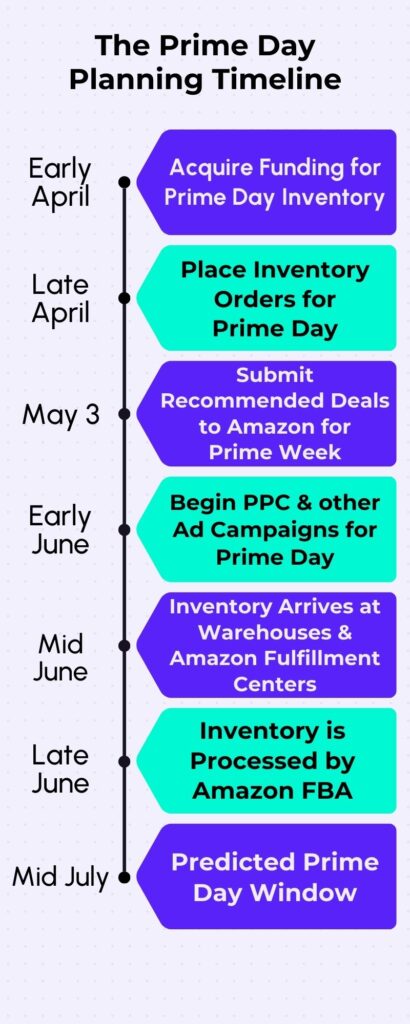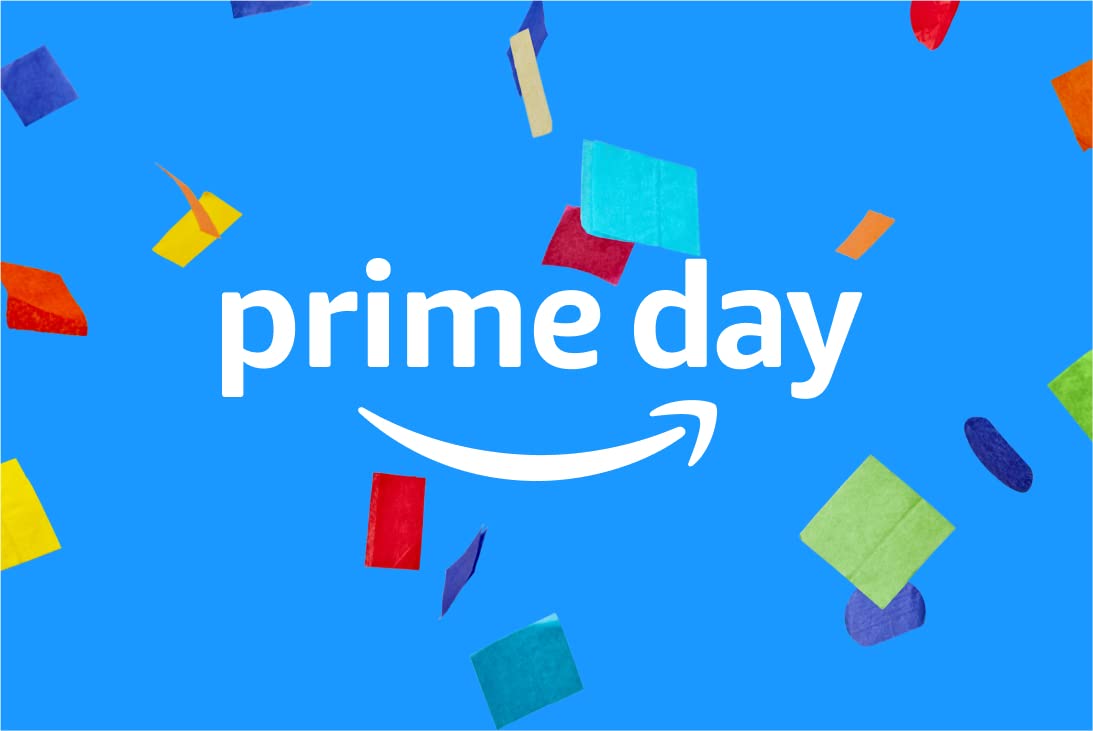While Amazon’s Prime Day may feel far away right now, Prime Day marketing planning starts months in advance for sellers who hope to make the most of the massive shopping event. If you want to drive sales and revenue this Prime Day, it’s wise to begin strategizing for success now, while there’s still time to get a competitive edge. By harnessing the substantial traffic expected during Amazon’s upcoming Prime Day, you can utilize the event as a pivotal opportunity to achieve your sales targets for Q3 and beyond.
If this marks your inaugural Prime Day as an Amazon seller, embarking on the comprehensive planning required for this significant eCommerce event can seem overwhelming. Yet, rest assured, you’re not navigating this journey solo. In this blog, we’ll delve into the Prime Day planning timelines and provide actionable strategies to kickstart your preparations.
History of Prime Day
Since the inception of Amazon Prime Day in 2015, the two-day, the Prime-subscriber exclusive holiday has become a staple shopping event for both sellers and customers. Over the years Prime Day has developed a “Christmas in July” feel, kicking off the third fiscal quarter with a huge eCommerce shopping event and driving sales. The event has injected fresh financial vigor into a season that was previously characterized by a sales slump for many businesses.
The 2023 Prime Day was the largest to date for Amazon and marketplace sellers alike, with record-breaking sales on all fronts. It was also the first year that independent Amazon sellers on the platform outpaced Amazon’s own retail business–and not by a small margin.
Prime Day Timelines 2024

While Amazon has yet to officially release dates for Prime Day 2024, historically we can expect it to fall around the second week of July. Many Amazon sellers have also reportedly received a notification from Amazon Seller Central that “recommended deals” should be submitted to Amazon by May 3, 2024 for the chance to be selected for “Prime Day Week,” indicating that the shopping event may be extended even further this year…yes potentially a full week!
Since Amazon has yet to release any exact dates regarding Prime Day, this timeline remains a loose suggestion based on previous years. However, we have found that the sooner Amazon sellers begin Prime Day planning, the more successful and profitable they are for the second half of the year. By remaining ahead of the competition, your business will maintain a competitive advantage through agility.
As more dates are released we’ll update this timeline, but be sure to keep an eye on Viably’s social channels to be the first to hear.
Prime Day Planning: What to Do and When
Experienced Amazon sellers know that it’s important to leave a healthy buffer to guarantee that everything is set for Prime Day. When it comes to large sales events, more time can help your business ensure that there’s a buffer in case of unforeseen supply chain circumstances. That extra time can become critical if you need to pivot in response to delays, market upsets, or any number of unexpected (but often inevitable) challenges.
While the exact amount of preparation required for a successful Prime Day varies from seller to seller, based on business model and your current point in your cash conversion cycles, more time is always better. Regardless of whether you’re simply restocking inventory at an Amazon fulfillment center or you’re working to get your cash flow to a healthy place, four weeks is the bare minimum cushion you should have in place to ensure you’re ready. Ideally though, sellers will begin preparing around three months in advance with working capital.
Refresh & Restock Inventory
In past years, Prime Day has become notorious for seeing stockouts on highly coveted items. Customers are quick to snag a good deal, and if you’re running a serious sale on a well-established product it’s likely to be met with plenty of demand. To meet that customer demand and ensure that you can truly maximize sales throughout the event it’s critical that you assess your historical data and restock now.
Buying in bulk will not only help you to meet demand for highly anticipated deals, it can also provide you, as an Amazon seller, with leverage when negotiating with suppliers. The lower cost per unit you can secure, the more competitive deals that you can create for customers. However, continue to be mindful of your sales numbers and maintain realistic margins. While many of Amazon’s shopping events lead into other holiday sales, Prime Day is not one of them. Instead, there will likely be a lull in sales following the event, until back-to-school season, depending on the category you’re selling in.
After placing your inventory order you can expect to wait between 6-8 weeks before it arrives at Amazon fulfillment and distribution warehouses. On top of that, the rush to get inventory prepared for the shopping event typically creates slowdowns for Amazon FBA processing. To avoid any delays and guarantee that your products are accounted for, it’s best to place inventory restock orders as soon as possible.
Launch New Products
As you dive into Prime Day planning, it’s essential to strategize not only for maximizing sales during the event but also for long-term growth. Incorporating new products into your catalog during this time can be a strategic move to capitalize on the heightened consumer interest and generate excitement among shoppers. Prime Day’s massive traffic and enthusiastic audience provide an ideal platform to launch new products, particularly trendy or seasonal items, amplifying sales potential and expanding your customer base.
However, to ensure a successful launch, meticulous listing optimization is key. Starting the optimization process well in advance allows you to fine-tune product listings, enhance visibility, and position your offerings for maximum exposure and sales traction during Prime Day.
By launching new products early you’ll be able to refine product listings, ensuring that they have all the necessary keywords to rank. Consider the time period leading up to the event as a “soft launch” to gather data, optimize product-market fit, and earn those coveted five-star reviews to secure consumer trust. Once your product is established on the marketplace you’ll be able to truly capitalize on sales and “hard launch” come Prime Day, allowing you to increase the price and improve profit margins.
Upgrade Your Marketing
Prime Day is the perfect opportunity to reach new customers and increase your product visibility with marketing. Remember though, amazing marketing doesn’t happen overnight and simply opting-in to Prime Day won’t guarantee success. Awareness of your product(s) starts long before a sales event, and requires consistent optimization.
Strong marketing across various channels, especially Amazon PPC, will direct potential customers to your product listings and help to increase conversion rates. But that’s only possible with a healthy budget. Start thinking about how much money you’re willing to invest in advertising and be sure that it’s allocated accordingly to ramp campaigns a couple weeks in advance. It’s also crucial to remember that increased customer traffic will mean more competition for PPC ads–meaning keyword bids will require a greater investment to be successful.
Consider utilizing ad campaigns to remind customers that your Prime Day deals are temporary, inciting a sense of urgency in them. Oftentimes shoppers simply need to be reminded that they need to “act now” in order to send your sales skyrocketing.
Win with Working Capital
If you’re hoping to participate in Prime Day, it will require a serious cash investment to see real success. While major shopping events can be incredibly lucrative for your business when correctly leveraged, they can deplete the cash reserves of many sellers. Bulk inventory purchases need to happen now, almost three months in advance, and can leave you skating by on tight cash flow margins until then. Plus you won’t see the payout for Prime Day until two weeks after the event, at the earliest.
Most Amazon Sellers can’t afford to truly maximize success during a major shopping event on their own cash flow. So where does the working capital to make it happen come from?
Now is the time to start looking for eCommerce funding solutions. Working capital from an eCommerce funding solution is typically cheaper and quicker to access than traditional banking loans, and often comes with terms that fit specifically to the ebbs and flows of eCommerce businesses. By securing funding from an eCommerce funding solution, like Viably today, you can start paying for inventory orders as soon as tomorrow. Offers from Viably are available in as little as 24 hours after submitting your application, and you can receive money in your bank account almost immediately upon acceptance.
While you might be able to squeeze a success out of Prime Day without working capital, funding will help to alleviate pressure on your cash flow. This cash flow buffer can provide you with the flexibility and opportunities to grow your business before Prime Day and beyond.

